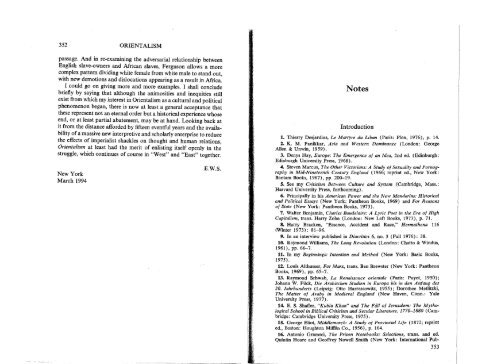Orientalism - autonomous learning
Orientalism - autonomous learning
Orientalism - autonomous learning
You also want an ePaper? Increase the reach of your titles
YUMPU automatically turns print PDFs into web optimized ePapers that Google loves.
352 ORIENTALISM<br />
passage. And in re-examining the adversarial relationship between<br />
English slave-owners and African slaves, Ferguson allows a more<br />
complex pattern dividing white female from white male to stand out,<br />
with new demotions and dislocations appearing as a result in Africa.<br />
I could go on giving more and more examples. I shall conclude<br />
briefly by saying that although the animosities and inequities still<br />
exist from which my interest in <strong>Orientalism</strong> as a cultural and political<br />
phenomenon began, there is now at least a general acceptance that<br />
these represent not an eternal order but a historical experience whose<br />
end, or at least partial abatement, may be at hand. Looking back at<br />
it from the distance afforded by fifteen eventful years and the availability<br />
ofa massive new interpretive and scholarly enterprise to reduce<br />
the effects of imperialist shackles on thought and human relations,<br />
<strong>Orientalism</strong> at least had the merit of enlisting itself openly in the<br />
struggle, which continues of course in "West" and "East" together.<br />
New York<br />
March 1994<br />
E.W.S.<br />
Notes<br />
Introduction<br />
1. Thierry Desjardins, Le Martyre du Liban (Paris: Plan, 1976), p. 14.<br />
2. K. M. Panikkar, Asia and Western Dominance (London: George<br />
Allen & Unwin, 1959).<br />
3. Denys Hay, Europe: The Emergence of an Idea, 2nd ed. (Edinburgh:<br />
Edinburgh University Press, 1968).<br />
4. Steven Marcus, The Other Victorians: A Study of Sexuality and Pornography<br />
in Mid-Nineteenth Century England (1966; reprint ed., New York:<br />
Bantam Books, 1967), pp. 200-19.<br />
S. See my Criticism Between Culture and System (Cambridge, Mass.:<br />
Harvard University Press, forthcoming).<br />
6. Principally in his American Power and the New Mandarins: Historical<br />
and Political Essays (New York: Pantheon Books, 1969) and For Reasons<br />
of State (New York: Pantheon Books, 1973).<br />
7. WaIter Benjamin, Charles Baudelaire: A Lyric Poet in the Era of High<br />
Capitalism, trans. Harry Zohn (London: New Left Books, 1973), p. 71.<br />
8. Harry Bracken, "Essence, Accident and Race," Hermathena 116<br />
(Winter 1973): 81-96.<br />
9. In an interview published in Diacritics 6, no. 3 (Fall 1976): 38.<br />
10. Raymond Williams, The Long Revolution (London: Chatto & Windus,<br />
1961), pp. 66-7.<br />
11. In my Beginnings: Intention and Method (New York: Basic Books,<br />
1975).<br />
12. Louis AIthusser, For Marx, trans. Ben Brewster (New York: Pantheon<br />
Books, 1969), pp. 65-7.<br />
13. Raymond Schwab, La Renaissance orientale (Paris: Payot, 1950);<br />
Johann W. FUck, Die Arabischen Studien in Europa bis in den Anfang des<br />
20. lahrhunderts (Leipzig: Otto Harrassowitz, 1955); Dorothee Metlitzki,<br />
The Matter of Araby in Medieval England (New Haven, Conn.: Yale<br />
University Press, 1977).<br />
14. E. S. Shaffer, "Kubla Khan" and The Fall of Jerusalem: The Mythological<br />
School in Biblical Criticism and Secular Literature, 1770-1880 (Cambridge:<br />
Cambridge University Press, 1975).<br />
15. George Eliot, Middlemarch: A Study of Provincial Life (1872; reprint<br />
ed., Boston: Houghton Miffiin Co., 1956), p. 164.<br />
16. Antonio Gramsci, The Prison Notebooks: Selections, trans. and ed.<br />
Quintin Hoare and Geoffrey Nowell Smith (New York: International Pub<br />
353
















